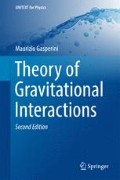Abstract
The geometric description of gravity so far presented has been developed using the language of classical differential geometry, based, in particular, on the notions of Riemannian metric g and Christoffel connection \(\varGamma \).
Access this chapter
Tax calculation will be finalised at checkout
Purchases are for personal use only
Author information
Authors and Affiliations
Corresponding author
Appendices
Exercises Chap. 12
12.1
Local Transformation of the Lorentz Covariant Derivative Check that Eq. (12.31) holds provided the Lorentz connection satisfies the transformation law (12.23).
12.2
Einstein Action in the Vierbein Formalism Show that the Einstein action (12.56) can be equivalently rewritten in the form (12.57).
12.3
Lorentz Derivative of the Totally Antisymmetric Tensor Show that \(D_\mu \epsilon ^{abcd}=0\).
12.4
Einstein Equations in the Vierbein Formalism Check that Eq. (12.63) is equivalent to the vacuum Einstein equations.
Solutions
12.1
Solution Let us explicitly write down the left-hand side of Eq. (12.31):
Note also that, for a vector field,
(see Eq. (12.29)). For the vector representation, the transformation (12.23) we can thus be rewritten as follows:
Inserting this result into Eq. (12.65), and simplifying, we obtain
which reproduces indeed the transformation of Eq. (12.31).
12.2
Solution Let us consider the result (3.38), and express one of the two antisymmetric tensors as a projection from its tangent-space counterpart. Equation (3.38) can thus be rewritten as
By inverting the projection on the curved indices \(\rho \) and \(\sigma \) we obtain:
Finally, by using the definitions (3.31) and (12.6), we can rewrite the above equation as follows:
Let us now observe that \(R_{\mu \nu }\,^{ab}\) is antisymmetric in the first two indices, so that:
Dividing by \(2 \chi \), and integrating over \(d^4x\), we thus arrive at the Einstein action in the form of Eq. (12.57).
12.3
Solution By applying the definition of Lorentz covariant derivative to the contravariant tensor representation in tangent space we have
As \(\epsilon \) is a totally antisymmetric tensor, the values of the four free indices appearing in the above equation, i.e. the indices a, b, c, d, must be all different. It follows that, in a four-dimensional space-time manifold, the four terms on the right-hand side of the above equation can be nonzero only if, in each of these terms, the two flat indices of the Lorentz connection take the same value (namely, if \(a=i\) in the first term, \(b=i\) in the second term, and so on). But the connection is antisymmetric, so that \(\omega _\mu \,^i\,_i \equiv 0\). The covariant derivative of \(\epsilon ^{abcd}\) is thus identically vanishing.
12.4
Solution Let us consider the product rule for totally antisymmetric tensors, Eq. (3.39), with three curved indices locally projected on the local tangent space,
Inserting this result into Eq. (12.63) we then obtain (recall the definition of R of Eq. (12.55))
The last term inside the round brackets exactly coincides with the Einstein tensor, and Eq. (12.63) is thus perfectly equivalent to the Einstein equations in vacuum.
Rights and permissions
Copyright information
© 2017 Springer International Publishing AG
About this chapter
Cite this chapter
Gasperini, M. (2017). Vierbeins and Lorentz Connection. In: Theory of Gravitational Interactions. UNITEXT for Physics. Springer, Cham. https://doi.org/10.1007/978-3-319-49682-5_12
Download citation
DOI: https://doi.org/10.1007/978-3-319-49682-5_12
Published:
Publisher Name: Springer, Cham
Print ISBN: 978-3-319-49681-8
Online ISBN: 978-3-319-49682-5
eBook Packages: Physics and AstronomyPhysics and Astronomy (R0)

